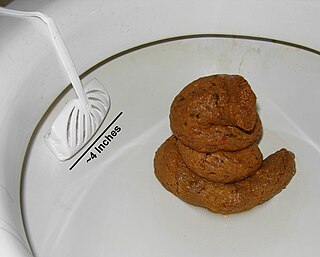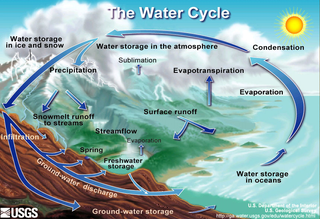Related Research Articles

Escherichia coli ( ESH-ə-RIK-ee-ə KOH-lye) is a gram-negative, facultative anaerobic, rod-shaped, coliform bacterium of the genus Escherichia that is commonly found in the lower intestine of warm-blooded organisms. Most E. coli strains are harmless, but some serotypes such as EPEC, and ETEC are pathogenic and can cause serious food poisoning in their hosts, and are occasionally responsible for food contamination incidents that prompt product recalls. Most strains are part of the normal microbiota of the gut and are harmless or even beneficial to humans (although these strains tend to be less studied than the pathogenic ones). For example, some strains of E. coli benefit their hosts by producing vitamin K2 or by preventing the colonization of the intestine by pathogenic bacteria. These mutually beneficial relationships between E. coli and humans are a type of mutualistic biological relationship — where both the humans and the E. coli are benefitting each other. E. coli is expelled into the environment within fecal matter. The bacterium grows massively in fresh fecal matter under aerobic conditions for three days, but its numbers decline slowly afterwards.

The fecal–oral route describes a particular route of transmission of a disease wherein pathogens in fecal particles pass from one person to the mouth of another person. Main causes of fecal–oral disease transmission include lack of adequate sanitation, and poor hygiene practices. If soil or water bodies are polluted with fecal material, humans can be infected with waterborne diseases or soil-transmitted diseases. Fecal contamination of food is another form of fecal-oral transmission. Washing hands properly after changing a baby's diaper or after performing anal hygiene can prevent foodborne illness from spreading.

Bacteriological water analysis is a method of analysing water to estimate the numbers of bacteria present and, if needed, to find out what sort of bacteria they are. It represents one aspect of water quality. It is a microbiological analytical procedure which uses samples of water and from these samples determines the concentration of bacteria. It is then possible to draw inferences about the suitability of the water for use from these concentrations. This process is used, for example, to routinely confirm that water is safe for human consumption or that bathing and recreational waters are safe to use.

Campylobacteriosis is among the most common infections caused by a bacterium in humans, often as a foodborne illness. It is caused by the Campylobacter bacterium, most commonly C. jejuni. It produces an inflammatory, sometimes bloody, diarrhea or dysentery syndrome, and usually cramps, fever and pain.
Plesiomonas shigelloides is a species of bacteria and the only member of its genus. It is a Gram-negative, rod-shaped bacterium which has been isolated from freshwater, freshwater fish, shellfish, cattle, goats, swine, cats, dogs, monkeys, vultures, snakes, toads and humans. It is considered a fecal coliform. P. shigelloides is a global distributed species, found globally outside of the polar ice caps.

Coliform bacteria are defined as either motile or non-motile Gram-negative non-spore forming bacilli that possess β-galactosidase to produce acids and gases under their optimal growth temperature of 35–37 °C. They can be aerobes or facultative aerobes, and are a commonly used indicator of low sanitary quality of foods, milk, and water. Coliforms can be found in the aquatic environment, in soil and on vegetation; they are universally present in large numbers in the feces of warm-blooded animals as they are known to inhabit the gastrointestinal system. While coliform bacteria are not normally the cause of serious illness, they are easy to culture, and their presence is used to infer that other pathogenic organisms of fecal origin may be present in a sample, or that said sample is not safe to consume. Such pathogens include disease-causing bacteria, viruses, or protozoa and many multicellular parasites. Every drinking water source must be tested for the presence of these total coliform bacteria.
A fecal coliform is a facultatively anaerobic, rod-shaped, gram-negative, non-sporulating bacterium. Coliform bacteria generally originate in the intestines of warm-blooded animals. Fecal coliforms are capable of growth in the presence of bile salts or similar surface agents, are oxidase negative, and produce acid and gas from lactose within 48 hours at 44 ± 0.5°C. The term thermotolerant coliform is more correct and is gaining acceptance over "fecal coliform".

Enterobacter is a genus of common Gram-negative, facultatively anaerobic, rod-shaped, non-spore-forming bacteria of the family Enterobacteriaceae. Cultures are found in soil, water, sewage, feces and gut environments. It is the type genus of the order Enterobacterales. Several strains of these bacteria are pathogenic and cause opportunistic infections in immunocompromised hosts and in those who are on mechanical ventilation. The urinary and respiratory tracts are the most common sites of infection. The genus Enterobacter is a member of the coliform group of bacteria. It does not belong to the fecal coliforms group of bacteria, unlike Escherichia coli, because it is incapable of growth at 44.5 °C in the presence of bile salts. Some of them show quorum sensing properties.
Wilderness-acquired diarrhea is a variety of traveler's diarrhea in which backpackers and other outdoor enthusiasts are affected. Potential sources are contaminated food or water, or "hand-to-mouth", directly from another person who is infected. Cases generally resolve spontaneously, with or without treatment, and the cause is typically unknown. The National Outdoor Leadership School has recorded about one incident per 5,000 person-field days by following strict protocols on hygiene and water treatment. More limited, separate studies have presented highly varied estimated rates of affliction that range from 3 percent to 74 percent of wilderness visitors. One survey found that long-distance Appalachian Trail hikers reported diarrhea as their most common illness. Based on reviews of epidemiologic data and literature, some researchers believe that the risks have been over-stated and are poorly understood by the public.
A coliphage is a type of bacteriophage that infects coliform bacteria such as Escherichia coli. Coliphage originate almost exclusively from human feces and from other warm-blooded animals. When certain circumstances are met, such as a large number of susceptible hosts present at the right temperature, they can only partially replicate in sewage and contaminated waters.
Indicator bacteria are types of bacteria used to detect and estimate the level of fecal contamination of water. They are not dangerous to human health but are used to indicate the presence of a health risk.

Food microbiology is the study of the microorganisms that inhabit, create, or contaminate food. This includes the study of microorganisms causing food spoilage; pathogens that may cause disease ; microbes used to produce fermented foods such as cheese, yogurt, bread, beer, and wine; and microbes with other useful roles, such as producing probiotics.
Campylobacter upsaliensis is a gram-negative bacteria in the Campylobacter genus. C. upsaliensis is found worldwide, and is a common cause of campylobacteriosis in humans, as well as gastroenteritis in dogs and cats. Human infections are primarily associated with raw or undercooked meat and contaminated water sources, however there is some zoonotic risk associated with the spread from dogs and cats. C. upsaliensis primarily affects the gastrointestinal tract as it damages gastrointestinal epithelial cells. There are many methods for detecting C.upsaliensis including PCR and ELISA, however there is no current gold standard in detection techniques. Infection is typically self limiting, however there is antimicrobial therapy available.
Indicator organisms are used as a proxy to monitor conditions in a particular environment, ecosystem, area, habitat, or consumer product. Certain bacteria, fungi and helminth eggs are being used for various purposes.

Human feces are the solid or semisolid remains of food that could not be digested or absorbed in the small intestine of humans, but has been further broken down by bacteria in the large intestine. It also contains bacteria and a relatively small amount of metabolic waste products such as bacterially altered bilirubin, and the dead epithelial cells from the lining of the gut. It is discharged through the anus during a process called defecation.

Freshwater environmental quality parameters are those chemical, physical or biological parameters that can be used to characterise a freshwater body. Because almost all water bodies are dynamic in their composition, the relevant quality parameters are typically expressed as a range of expected concentrations.
Enteroinvasive Escherichia coli (EIEC) is a type of pathogenic bacteria whose infection causes a syndrome that is identical to shigellosis, with profuse diarrhea and high fever. EIEC are highly invasive, and they use adhesin proteins to bind to and enter intestinal cells. They produce no toxins, but severely damage the intestinal wall through mechanical cell destruction.

Escherichia coli is a gram-negative, rod-shaped bacterium that is commonly found in the lower intestine of warm-blooded organisms (endotherms). Most E. coli strains are harmless, but pathogenic varieties cause serious food poisoning, septic shock, meningitis, or urinary tract infections in humans. Unlike normal flora E. coli, the pathogenic varieties produce toxins and other virulence factors that enable them to reside in parts of the body normally not inhabited by E. coli, and to damage host cells. These pathogenic traits are encoded by virulence genes carried only by the pathogens.

A beach advisory is a warning given by a local government to avoid swimming in a body of water. Beach advisories do not automatically close bodies of water to swimmers but instead function as a warning to swimmers against swimming at a particular site.
Diving equipment may be exposed to contamination in use and when this happens it must be decontaminated. This is a particular issue for hazmat diving, but incidental contamination can occur in other environments. Personal diving equipment shared by more than one user requires disinfection before use. Shared use is common for expensive commercial diving equipment, and for rental recreational equipment, and some items such as demand valves, masks, helmets and snorkels which are worn over the face or held in the mouth are possible vectors for infection by a variety of pathogens. Diving suits are also likely to be contaminated, but less likely to transmit infection directly.
References
- Gleeson, C. and Gray, N (1997). The Coliform index and waterborne disease: Problems of microbial drinking water assessment E&FN SPON: London.